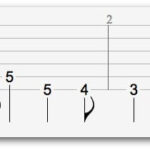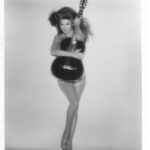The electric guitar, an instrument synonymous with modern music, boasts a history as rich and dynamic as the sounds it produces. While its explosion into mainstream culture is often linked to the rock and roll revolution of the mid-20th century, the journey of the electric guitar began much earlier, in the nascent years of the 1930s. This article delves into the fascinating evolution of the electric guitar, exploring its origins, diverse types, and enduring impact on music.
The necessity for amplification arose during the Big Band Era. As orchestras grew in size, particularly the brass sections, the acoustic guitar, a staple rhythm instrument, struggled to be heard. This sonic challenge spurred innovation, leading to the development of the first electric guitars. These early instruments were essentially hollow archtop acoustic guitars fitted with electromagnetic transducers, designed to convert string vibrations into electrical signals that could be amplified. By 1932, the dream of an electrically amplified guitar became a commercial reality. Pioneers in this burgeoning field included Rickenbacker (1932), Dobro (1933), National, Epiphone, and Gibson (all by 1935), among a growing number of manufacturers by 1936.
Gibson took a significant step forward in 1936 with the introduction of their first production electric guitar, the ES-150 model. The “ES” stood for “Electric Spanish,” and “150” denoted its price of $150 – a considerable sum at the time. A key feature of the ES-150 was its single-coil, hexagonally shaped pickup, the brainchild of engineer Walt Fuller. This pickup gained iconic status as the “Charlie Christian” pickup, named after the legendary jazz guitarist who championed the ES-150 and revolutionized guitar playing. Despite its initial popularity, the ES-150 had limitations, notably inconsistent volume across the strings.
Despite these early challenges, the electric guitar continued to evolve dramatically. It transcended its initial purpose as a louder acoustic instrument, becoming a versatile tool capable of producing a vast spectrum of sounds and musical styles. The electric guitar became a cornerstone in the development of rock ‘n’ roll and countless other genres, fundamentally reshaping the landscape of modern music.
Exploring the Diverse World of Electric Guitars: Types and Tones
The electric guitar family is incredibly diverse, with different body styles contributing significantly to their sonic characteristics and playing styles. Let’s explore the primary types:
Solid Body Electric Guitars: Sustain and Powerhouses
Solid body guitars are defined by their construction: they feature bodies made entirely of solid wood. Apart from necessary cavities for pickups and electronic controls, there are no hollow or chambered areas. This solid construction is the key to their defining characteristic: exceptional sustain. Compared to semi-hollow and hollowbody guitars, solid bodies resonate less freely in the body itself, focusing the vibration and energy on the strings and pickups, resulting in notes that ring out for longer.
A classic solid body electric guitar, the Fender Stratocaster, known for its versatile sound and comfortable design.
Iconic solid body guitars that have shaped music history include the Gibson Les Paul, renowned for its thick, warm tone and sustain; the Gibson SG, known for its lighter weight and aggressive sound; and the Fender Stratocaster and Telecaster, celebrated for their bright, articulate tones and versatility.
The development of the solid body electric guitar was a gradual process. Les Paul, a pioneering guitarist and inventor, created “The Log,” one of the earliest solid-body prototypes. However, Gibson, initially hesitant, didn’t immediately embrace the solid-body concept, doubting its market appeal. Fender took the lead in mass production with the Broadcaster (later renamed Telecaster) in 1948, predating Gibson’s Les Paul, which emerged soon after as a direct competitor. The Fender Stratocaster, launched in 1954, further revolutionized the electric guitar, gaining immense popularity in the 1960s and 70s thanks to its expanded tonal possibilities, player-friendly ergonomics, and striking design.
Semi-Hollowbody Electric Guitars: Blending Resonance and Versatility
Semi-hollowbody guitars strike a balance between solid and hollow body designs. They incorporate a hollow body, or portions of it, along with a solid center block. This construction method results in a unique tonal character. Like solid body guitars, pickups capture string vibrations, but the resonating hollow sections also contribute to the overall sound. This blend produces a tone that is often described as warm, airy, and versatile, capable of sounding sweet, plaintive, or funky.
A Gibson ES-335 semi-hollow electric guitar, favored for its warm, versatile tone suitable for blues, jazz, and rock.
Semi-hollowbodies are popular across diverse genres, including blues, funk, 60s pop, and indie rock, prized for their tonal flexibility. Visually, they often feature cello-style F-shaped soundholes. However, these soundholes can sometimes be blocked or partially sealed to reduce feedback, a technique famously employed by blues legend B.B. King on his beloved “Lucille” guitars.
Full Hollowbody Electric Guitars: Jazz Heritage and Acoustic Qualities
Full hollow-body guitars represent the closest lineage to traditional acoustic guitars within the electric guitar family. They feature large, deep, fully hollow bodies. Their acoustic resonance is significant enough that they can be played at volumes comparable to acoustic guitars, making them suitable for unplugged performances in intimate settings.
A Gretsch full hollow body electric guitar, exemplifying the classic “jazzbox” style with its warm, rich tone.
Originating in the jazz age of the 1920s and 30s, full hollowbodies remain the quintessential “jazz guitar,” often nicknamed the “jazzbox.” Like semi-hollow guitars, they frequently feature f-holes. Typically equipped with humbucker pickups (sometimes just a neck pickup) and heavier gauge strings, jazzboxes are known for their warm, rich, and mellow tone. A variation, popular in country and rockabilly music, incorporates single-coil pickups and sometimes a Bigsby tremolo system, resulting in a distinctly twangier, more biting tone compared to the classic jazzbox.
Choosing Your First Electric Guitar: A Beginner’s Pathway
Embarking on your electric guitar journey is exciting, and selecting the right beginner instrument is crucial. Brands like Squier (Fender’s more affordable sibling), Epiphone (Gibson’s counterpart), and Ibanez are widely recognized for offering excellent electric guitars tailored for beginners.
To pinpoint the ideal starter electric guitar for you, consider the type of music that inspires you and the features that align with your musical aspirations. Hands-on experience is invaluable – trying out different guitars is highly recommended to find one that feels comfortable and inspiring in your hands. For further guidance, resources like “how to shop for electric guitar beginners guide” and “electric guitars for beginners collection” offer valuable insights and model suggestions.
The Science of Sound: How Electric Guitars Produce Music
Electric guitars operate on electromagnetic principles to generate sound. They rely on pickups, typically mounted beneath the strings on the guitar body. These pickups are essentially magnets surrounded by wire coils, creating a magnetic field. When the metal strings are strummed or plucked, their vibrations disrupt this magnetic field. This disruption induces a small electrical current within the pickup coils.
This electrical current, representing the string vibrations, is then transmitted through the guitar’s internal circuitry, including volume and tone controls. A guitar cable is used to connect the electric guitar to a guitar amplifier. The amplifier receives the weak electrical signal from the guitar and boosts it significantly, driving speakers to produce the amplified sound we hear.
Electric Guitar Pricing: A Spectrum of Options
The price range for electric guitars is remarkably broad, spanning from budget-friendly models around $100 to high-end, collectible instruments costing tens of thousands of dollars. Several factors influence price, including brand reputation, the quality of materials used in construction, and included features.
For beginners, excellent entry-level electric guitars are commonly found in the $200-$400 range. Intermediate-level guitars, offering enhanced features and quality, often fall in the $400-$800 range. High-end electric guitars designed for advanced players typically start around $800 and can extend to $2000 or more. Premium, hand-made, or limited-edition electric guitars, such as those from Fender Custom Shop and Gibson Custom, frequently command much higher prices, reflecting their exclusivity and craftsmanship.
Iconic Electric Guitar Models: Legends in Wood and Wire
Certain electric guitar models have achieved legendary status, becoming iconic symbols of music history and player favorites across generations. Among the most popular and influential are the Fender Telecaster, celebrated for its pioneering design and twangy tone; the Fender Stratocaster, revered for its versatility and ergonomic design; the Gibson Les Paul, known for its powerful sustain and rich tone; the Gibson ES-335, a versatile semi-hollowbody favored in blues and rock; and the Gibson SG Standard, known for its lightweight design and aggressive rock sound.
For deeper insights into these legendary models, resources like “Top 5 Most Popular Electric Guitars” provide detailed information and comparisons.
The electric guitar stands as a testament to musical innovation and evolution. From its humble beginnings in the Big Band era to its current status as a cornerstone of virtually every modern music genre, the electric guitar continues to inspire musicians and captivate audiences worldwide. Whether you are a seasoned player or just beginning your musical journey, exploring the world of electric guitars opens up a universe of sonic possibilities.


